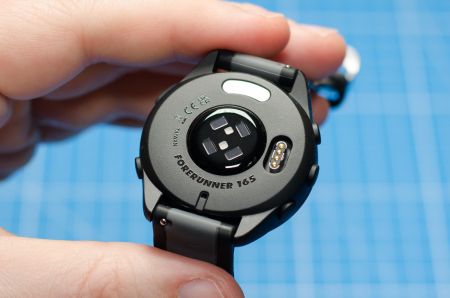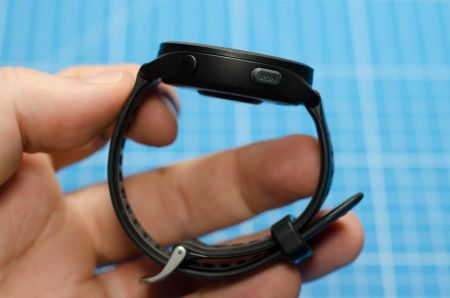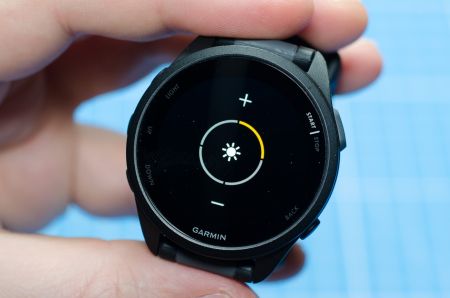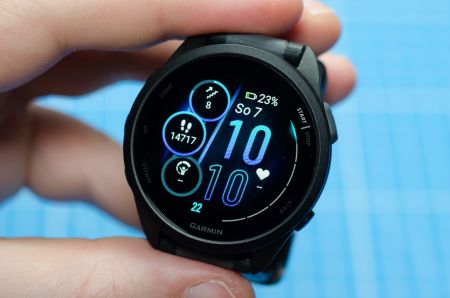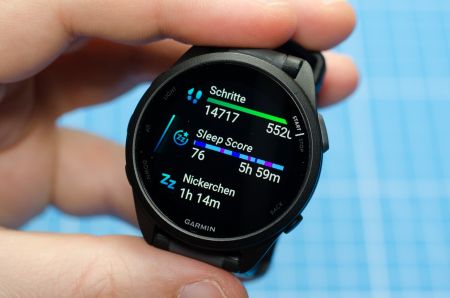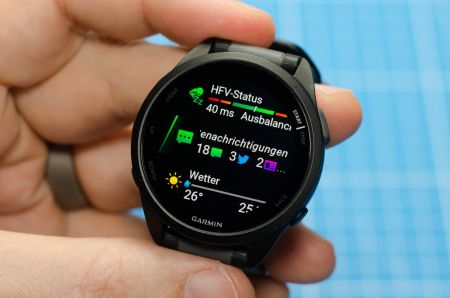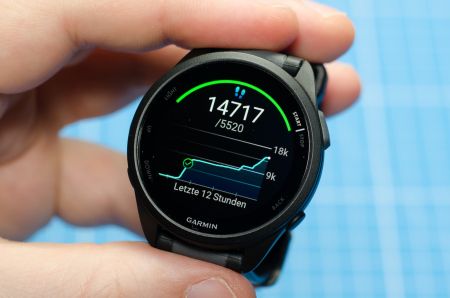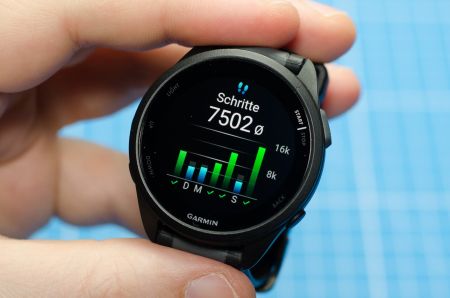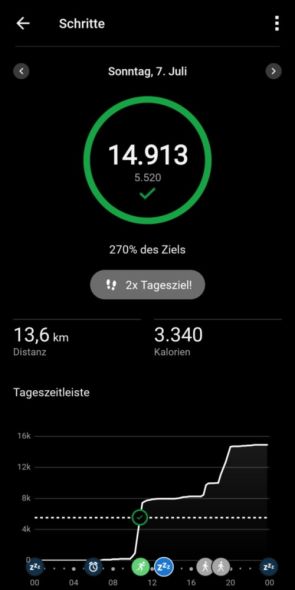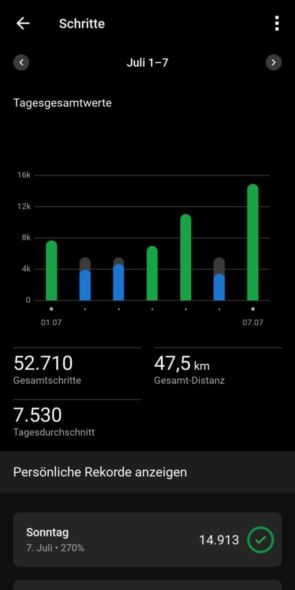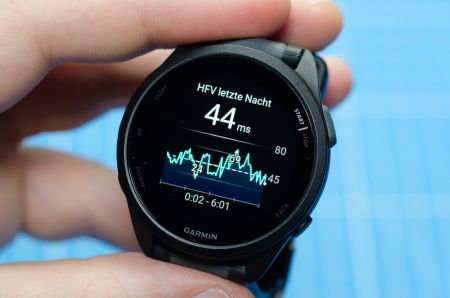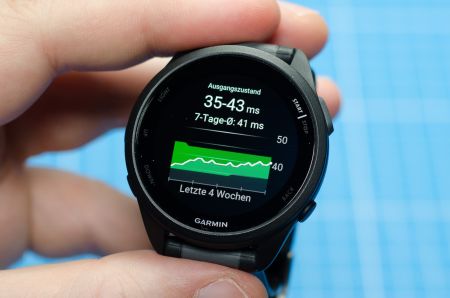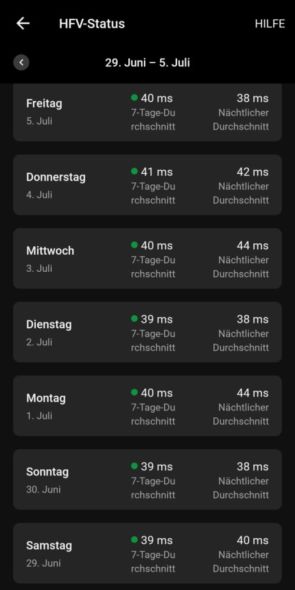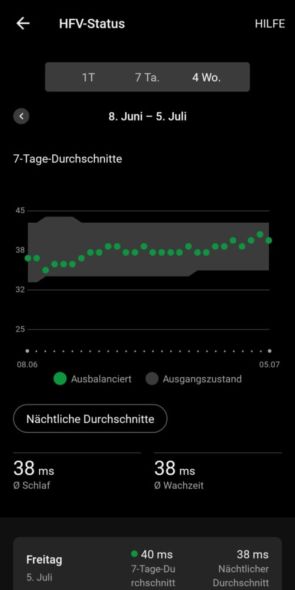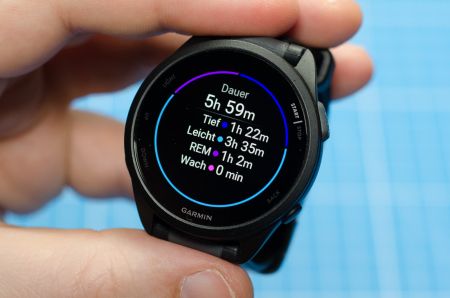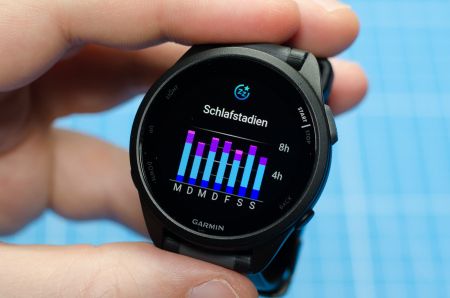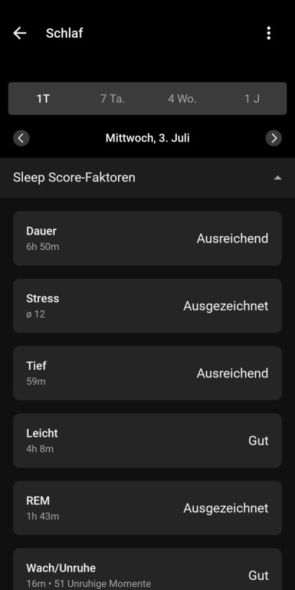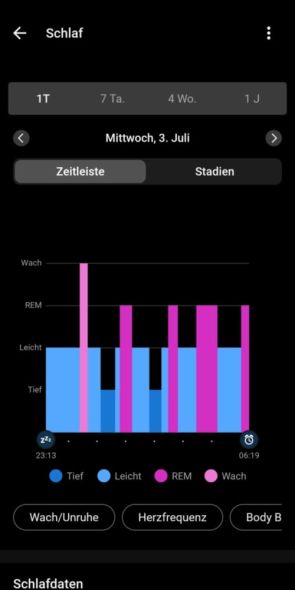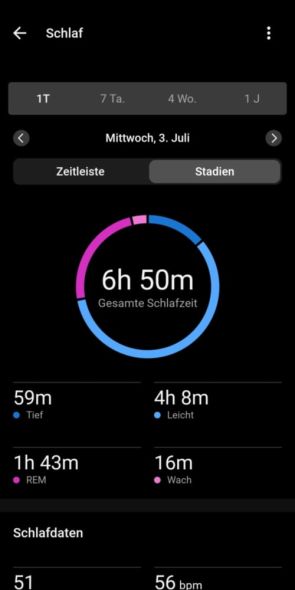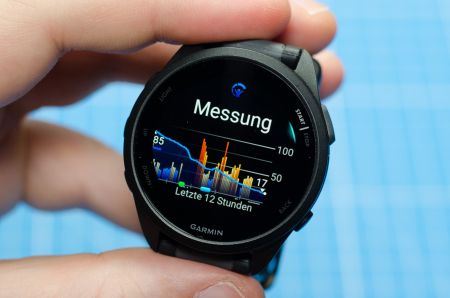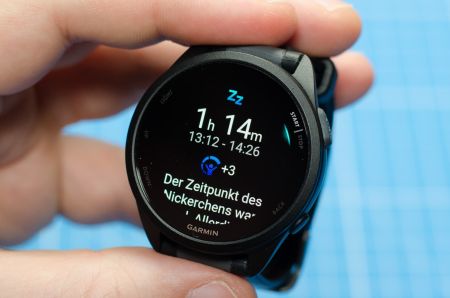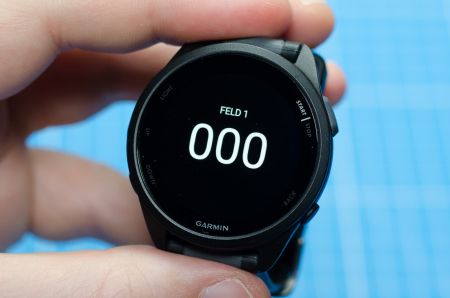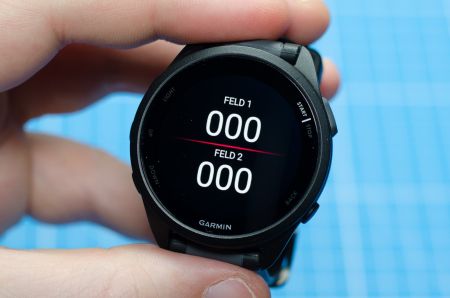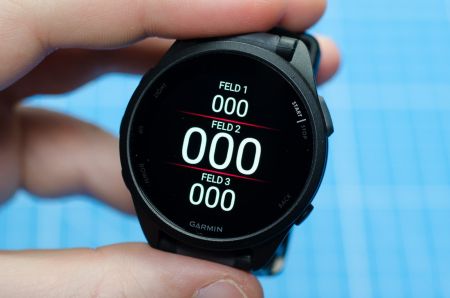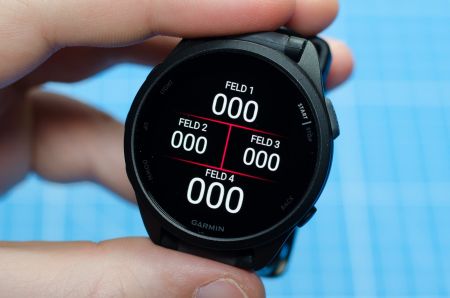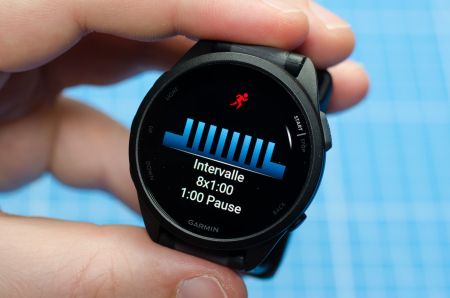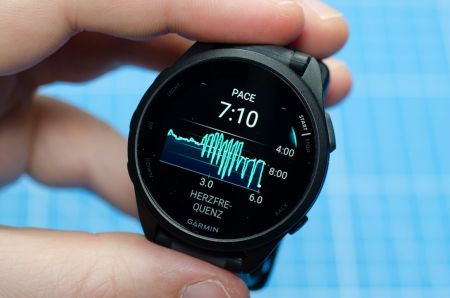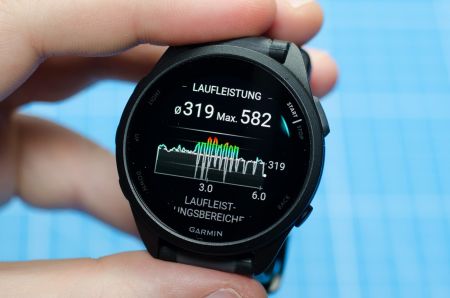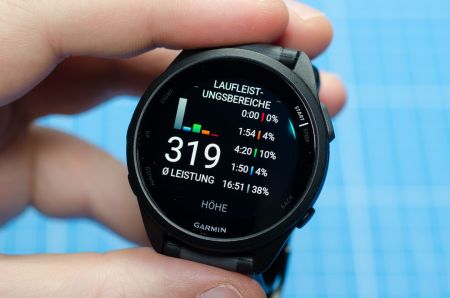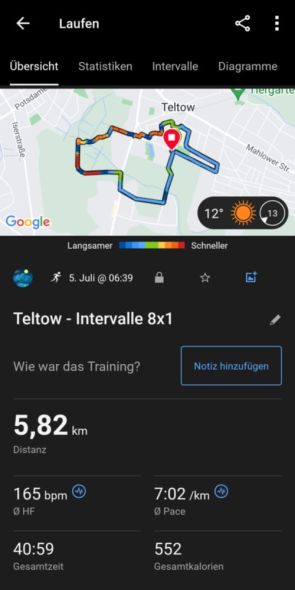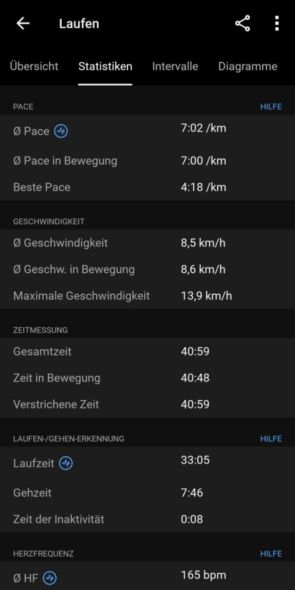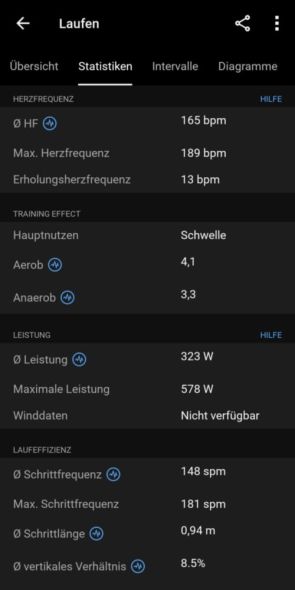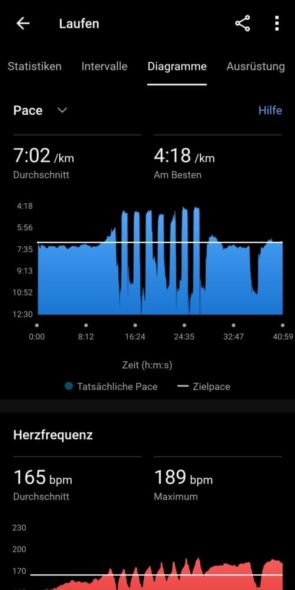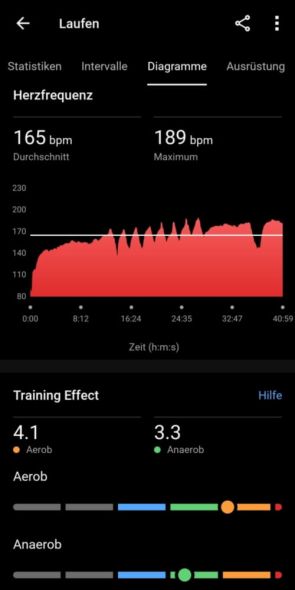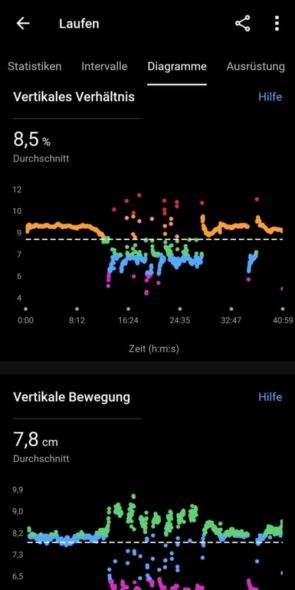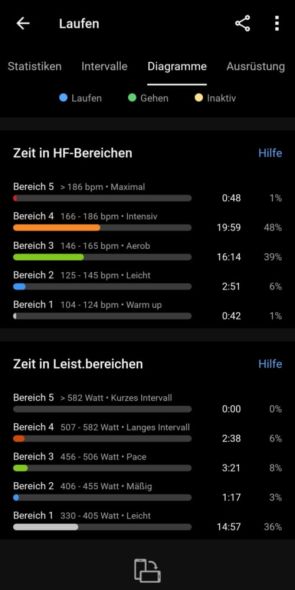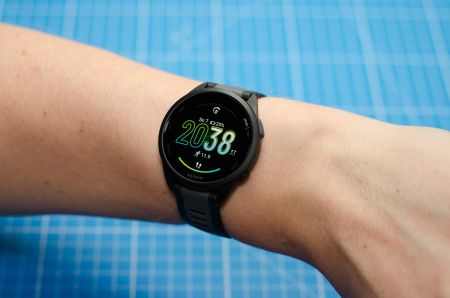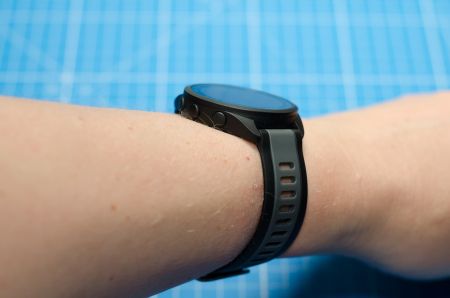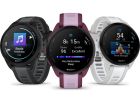Garmin Forerunner 165 Review: Budget, still feature-packed
If you’re on the hunt for a top-notch sports watch, Garmin’s offerings are hard to overlook. Among them, the Forerunner 165 stands out with its impressive blend of lightweight design and a comprehensive suite of features. Having extensively reviewed this model, I can attest to its blend of practicality and performance.
With the Forerunner 165, Garmin introduced a watch that not only broadened the existing lineup but also established a new category within the Forerunner series. Positioned strategically between the entry-level Forerunner 55 and the mid-range Forerunner 265, the Forerunner 165 bridges the gap between basic and advanced features.

Garmin provided me with the Forerunner 165 for a 60-day testing period upon my request. As always, there are no conditions or obligations attached. And because it is a loan, the watch will return to Garmin after the testing period.

- great display
- feature-packed
- no multisport / triathlon
- no training load / training readiness
- lots of plastic
Verdict
The Garmin Forerunner 165 is dedicated to running and offers most of its functions in this area but is equally suitable for many other sports. I was impressed by the great display and the mix of functions that the watch inherited from significantly more expensive models. The Forerunner 165 leaves little to be desired, but the decision for the watch is not an easy one.
There are good alternatives from Garmin and competitors – Garmin has not really occupied a niche with the Forerunner 165. Yet, it is the overall package that makes the Forerunner so attractive for entry into Garmin’s sports segment.
Forerunner 165 – What’s new and noteworthy?
Typically, watches within a product line evolve incrementally from one generation to the next — such as the Forerunner 245 evolving into the Forerunner 255, and then the Forerunner 265. This makes it straightforward to compare successive generations within the same series.
However, with the introduction of a completely new product line, comparing the new model requires a broader perspective. In this case, positioning the Forerunner 165 involves looking at the adjacent models: the more affordable Forerunner 55 and the higher-end Forerunner 265. This approach helps in better understanding the new model’s place within Garmin’s lineup.
Distinction from Forerunner 55
The Forerunner 55, now three years old, is considered quite outdated in the rapidly evolving world of wearables. The difference between the Forerunner 55 and the Forerunner 165 is striking, particularly in their displays. The Forerunner 55 is equipped with a 1.04″ transflective MIP display, whereas the Forerunner 165 boasts a 1.2″ AMOLED touchscreen with a much higher resolution.
Comparing the features of these two watches would be like comparing day and night. The Forerunner 165 benefits from the latest fourth-generation Elevate sensors, whereas the Forerunner 55 relies on the third generation, underscoring the significant advancements in technology and features.
Distinction from Forerunner 265
Distinguishing the Forerunner 165 from the Forerunner 265, which debuted in March 2023, is more straightforward.
Starting with the display, Garmin basically uses the same touch-capable AMOLED screen for both models. However, the Forerunner 265 is available in two sizes: 1.1″ and 1.3″, compared to the Forerunner 165’s 1.2″ display.
Functionally, the Forerunner 165 offers fewer features than the higher-end Forerunner 265. As a buyer of the Forerunner 165, you will need to forgo the following advanced features:
- Multiband GPS
- Training Readiness
- Training Status
- Training Load
- Support for Multisport/Triathlon
- Greater range of sports profiles
- Sat-IQ
- Pace adjusted to incline
- Connection to power meters/smart meters
The list is by no means exhaustive, but it would get lost in detail. These are the main features that the Forerunner 165 does not offer.
Features of the Forerunner 165 at a glance
When comparing the Forerunner 165 to the Forerunner 265, the list of differences can seem extensive, which might overshadow the fact that for most athletes, the Forerunner 165 is an exceptionally well-rounded sports watch. While it may lack some advanced metrics and features found in the Forerunner 265, these omissions are unlikely to be missed in the initial months or even years of use.
With this perspective in mind, here’s a concise overview of the key features of the Forerunner 165 before we dive into the details:
- 1.2″ AMOLED display (touch-capable, hardened glass)
- 39 g lightweight plastic case with silicone strap
- Elevate V4 sensor
- Multi-GNSS (GPS, GLONASS, Galileo, etc.)
- Garmin Pay
- Music playback (MP3, Spotify, Amazon Music, YouTube Music, Deezer)
- Barometric altimeter
Unboxing and first impression
As is typical with Garmin, the Forerunner 165 comes packaged in a compact gray box, adorned with the product name and an image of the sports watch. This model is offered in a variety of colors including turquoise, berry, white, and black.
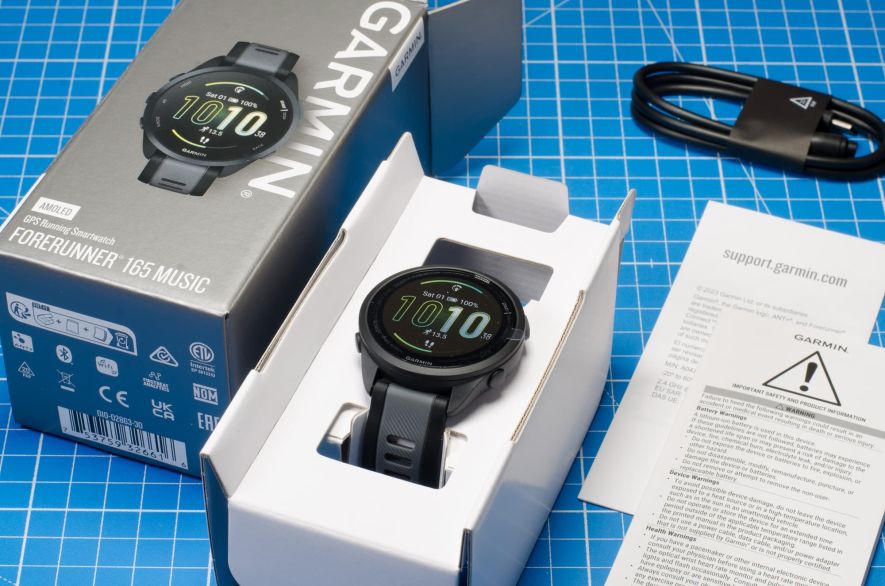
There’s nothing particularly surprising about the packaging, so I’ll keep this brief:
- Garmin Forerunner 165
- Strap (circumference: 126 – 203 mm)
- USB charging cable (USB-C to proprietary)
- Warranty/safety instructions
Garmin has been using the same 4-pin connector for the charging port for years. However, the other end of the cable now features a USB-C connector.
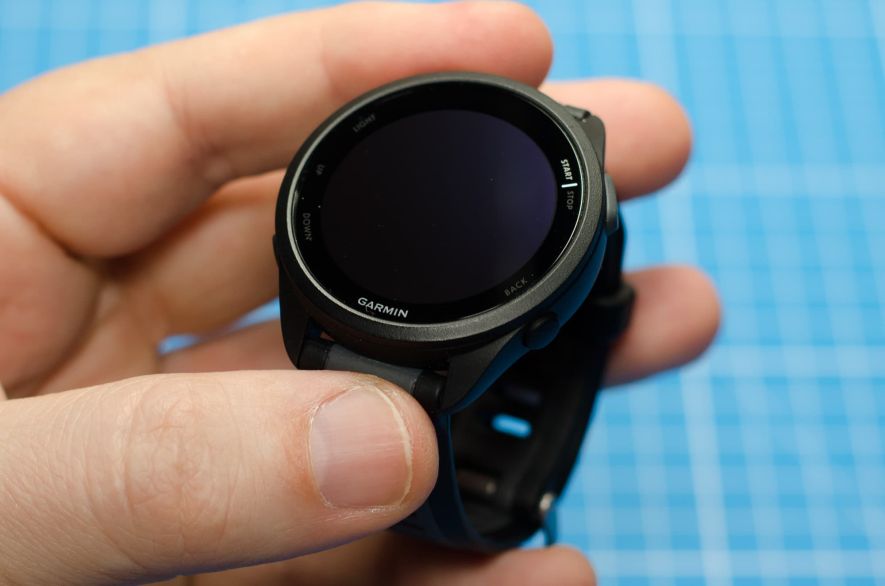
Overall, the build quality of the Forerunner 165 is good. The extensive use of plastic is typical for the Forerunner series, resulting in a low weight and a somewhat less premium appearance.
Case, back, and buttons – everything is made of plastic but is well crafted. Gaps are rare, and when they do exist, they are even and small.
Forerunner 165: A Basic Operation Guide
The Forerunner 165 features the typical 5-button design found on most Garmin sports watches. Two of the three buttons on the left side are primarily for navigating through menus and functions, while the third button manually turns the display on and off.
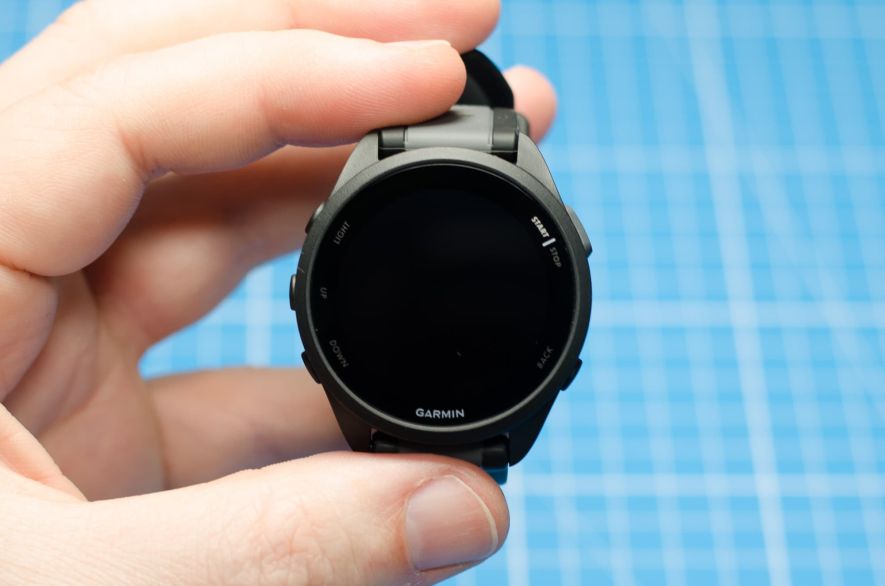
The buttons on the right side of the case allow you to:
- Start features / activities
- Stop features / activities
- Access menu items
- Go back
At the same time, the Forerunner 165 can be fully operated using the touch display. The choice is yours.
Display of the Forerunner 165
As it is a good fit here, let me briefly share my impressions of the AMOLED display:
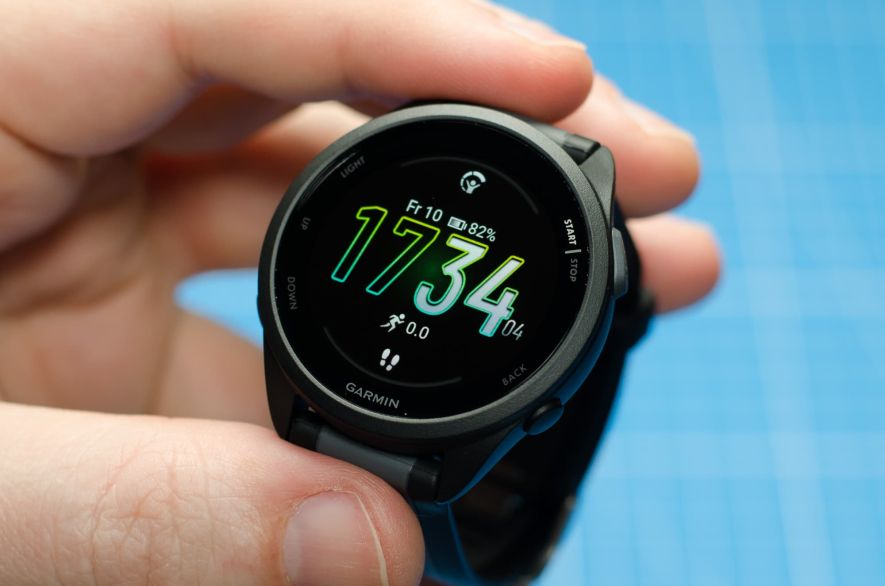
The display offers a 1.2″ size, which is the middle ground between the Forerunner 265S and the Forerunner 265. Initially, I thought a 1.3″ display wouldn’t be bad, but the smaller display looks great on my wrist.
The contrast, colors, and brightness of the display are impressive. Even in direct sunlight, the contents are easily readable.
To ensure the display doesn’t light up the bedroom at night, the watch adjusts the brightness to a lower level. The “night times” can be individually set for each day of the week.
The watch also includes a flashlight using the display at a bright setting. While not as powerful as those in the Fenix 7 and Epix 2, it is useful for certain purposes.
There are now numerous watch faces (i.e., function-enriched watch dials) available – either pre-installed or downloaded to the watch via Connect IQ.
From the watch face, you can access the widgets using the up/down buttons or by swiping up/down. These are small, three-line views of individual metrics, such as HRV status, step count or sleep.
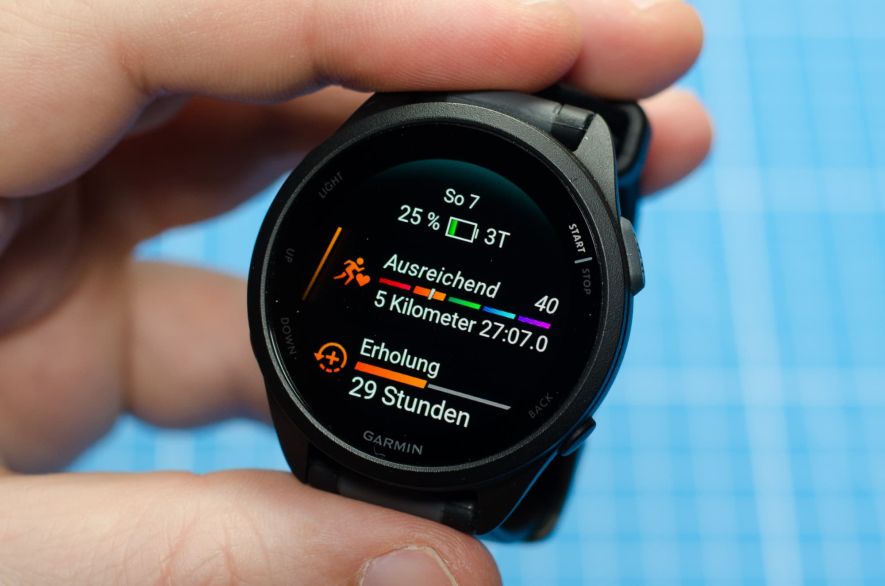
By tapping or selecting widgets using the button, you can access the corresponding detailed views. The display showcases its strengths with its high resolution.
The same information that you see on the watch can be found in the Connect app, which Garmin offers for free for iOS and Android.
Functions in Everyday Life
Many of the Forerunner 165’s features come from the higher-end models. Among the newer ones is the HRV status, which the watch determines during sleep. To obtain comparable values, patience is required initially, as the watch needs 19 nights to establish a baseline.
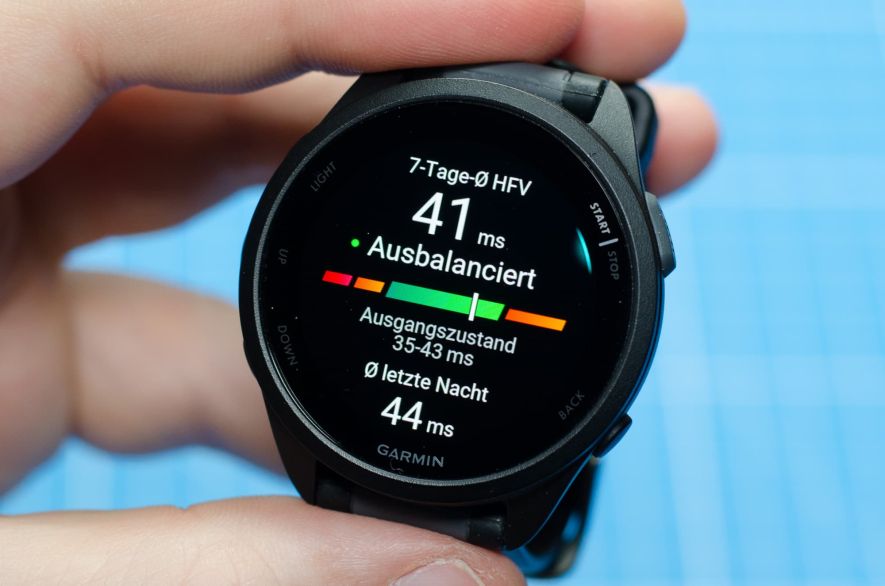
After that, the HRV status is displayed either in a widget or as part of the Morning Report.
Reminder: Heart Rate Variability (HRV) measures the time difference between consecutive heartbeats. Higher HRV values generally indicate better adaptability to stress, as they reflect a more flexible autonomic nervous system. However, this should be interpreted relative to an individual’s baseline. Therefore, a person with an HRV of 65 ms is not necessarily healthier or more resilient than someone with an HRV of 30 ms.
The watch displays the average HRV from the previous night and compares it to the average HRV from the past four weeks.
This information is also available in the app, which is particularly useful for evaluating data over longer periods.
This brings me to the Morning Report, which, in addition to the HRV status, summarizes the most important values (from the previous day, night, and the upcoming day) in a simple manner.
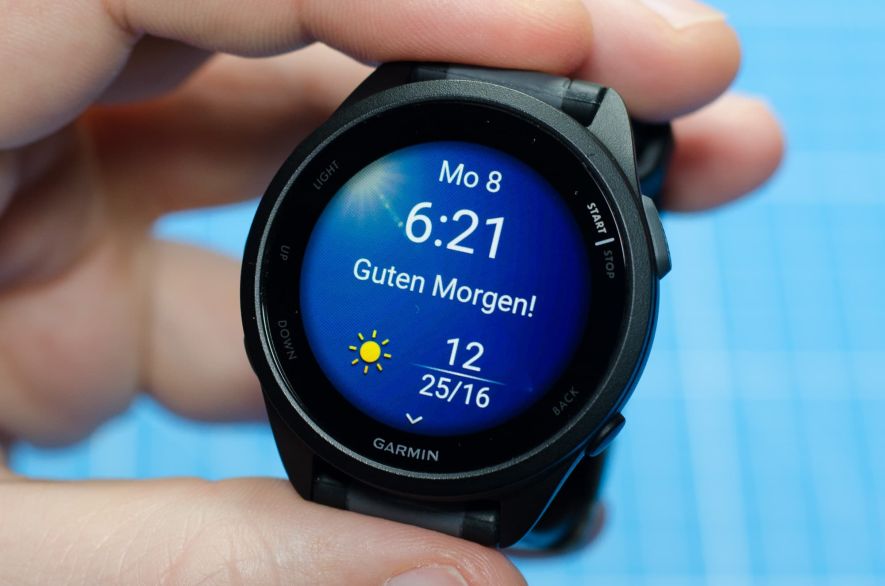
The watch breaks down sleep into phases and tracks sleep duration. While these metrics provide valuable insights, they are indicative rather than definitive. A professional sleep lab would offer much more precise and comprehensive data. However, in my perception, the sleeping and waking times fit very well.
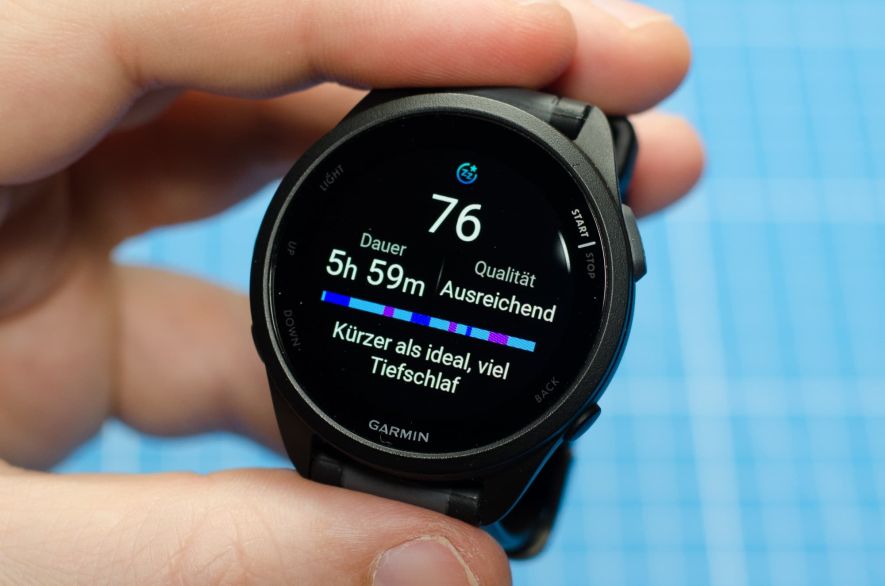
Once again, the watch provides insights into recent data only, while the app offers summaries on a weekly, monthly, or yearly basis.
Speaking of sleep: as you know, it helps replenish your energy reserves, which Garmin represents as the Body Battery, depleting over the day – especially with high stress and activities.
But not only nighttime sleep provides new energy; Garmin’s Nap Detection reliably recognizes daytime naps as well.
In the Music variant, the Forerunner 165 allows storing and especially playing music via Bluetooth-connected headphones or speakers. Pairing with headphones from Shokz, Jabra, and Soundcore worked without any issues.
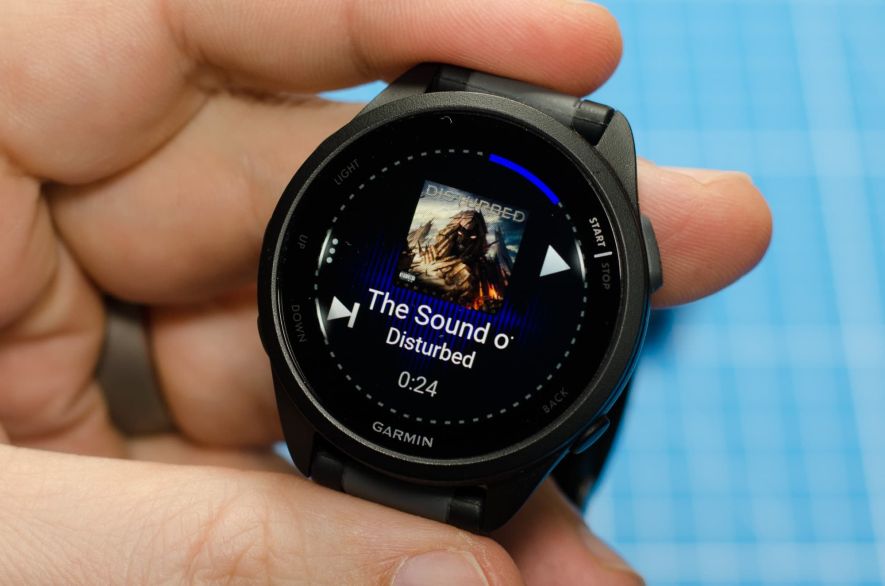
Honestly, having the option to enjoy music is a fantastic feature that provides entertainment and distraction from your heavy breathing during sports. Personally, I’m not concerned with whether the Sony Walkman NW-A306 or a similar device sounds significantly better. While the expectations might be different when relaxing at home, on the track, other aspects are more important. I appreciate being able to leave my smartphone at home just for the sake of enjoying music.
Forerunner 165 for Sports
Anyone opting for a Forerunner model generally has sports in focus, and given its price, the Forerunner 165 is easily convincing in this regard.
The sport mode is activated by pressing the upper right button. Numerous sport profiles are available, although the list is more concise compared to Garmin’s higher-priced models or competitors.
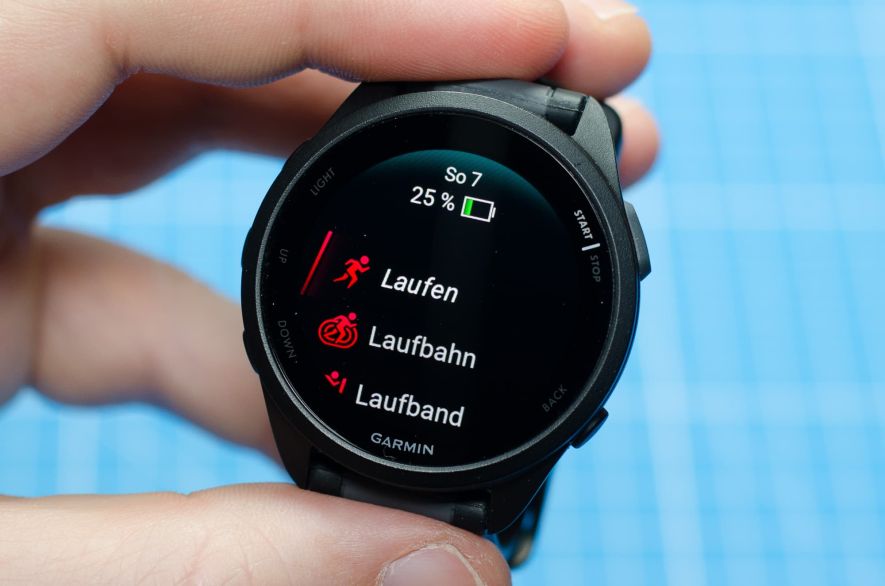
In addition to the basic sports, the Forerunner 165 also offers exotic options such as Pickleball and Padel.
Besides simple documentation, a sport profile serves as a set of settings to be applied when selecting the profile.
This includes data pages and data fields, with each data page accommodating between 1 to 4 fields. You can display a wide range of current and averaged values, as well as small charts, to suit your needs.
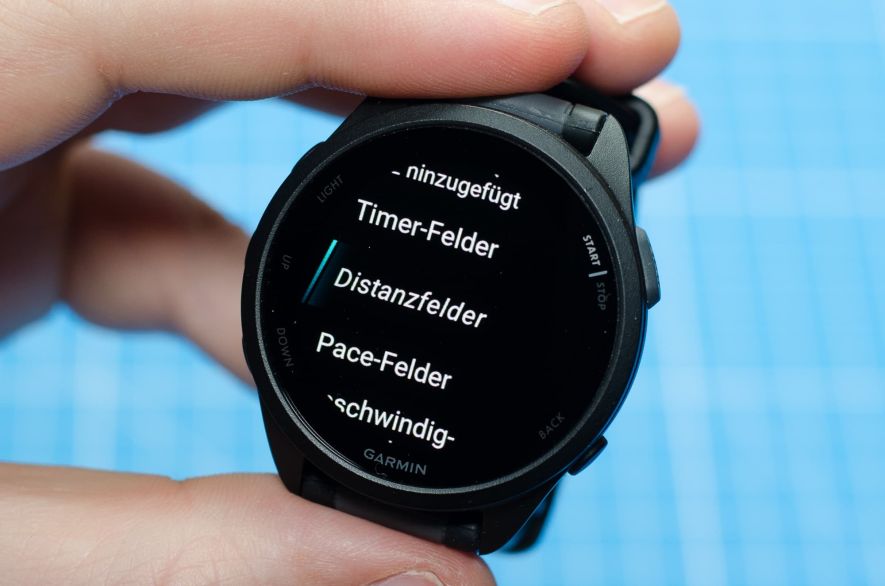
A unique feature is the running metrics and running power, which are quite rare for an entry-level watch.
As usual, alarms can also be set up, allowing for targeted training (e.g. by heart rate, pace, or running power).
Speaking of targeted training: in addition to the free training modes, the Forerunner 165 also suggests workouts based on your performance and the load from previous days.
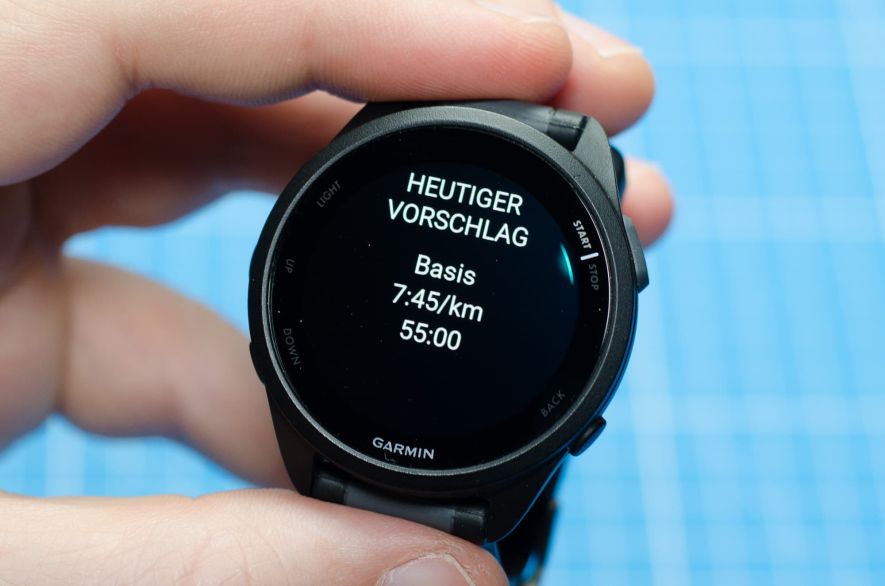
From my experience with running, these recommendations can be valuable at times but also occasionally puzzling: Eight minutes per kilometer is too slow for me, while a pace of 5:30 minutes, even for just 25 minutes, is quite challenging for me.
Since I needed some more custom test data for this report, I politely but firmly ignored the recommendation.
In addition to Garmin’s training suggestions, custom workouts can be stored in Garmin Connect and called up before starting a session. This makes intervals or following a route easily possible.
To give some context: The Forerunner 165 allows you to follow breadcrumb trails, meaning it provides route guidance without referencing or displaying maps. Essentially, you follow a virtual line on the ground.
Routes can be defined in Garmin Connect, as well as on third-party platforms like Komoot, and transferred to the watch. Routes that have been completed but not explicitly defined beforehand can be tracked later as route guidance.
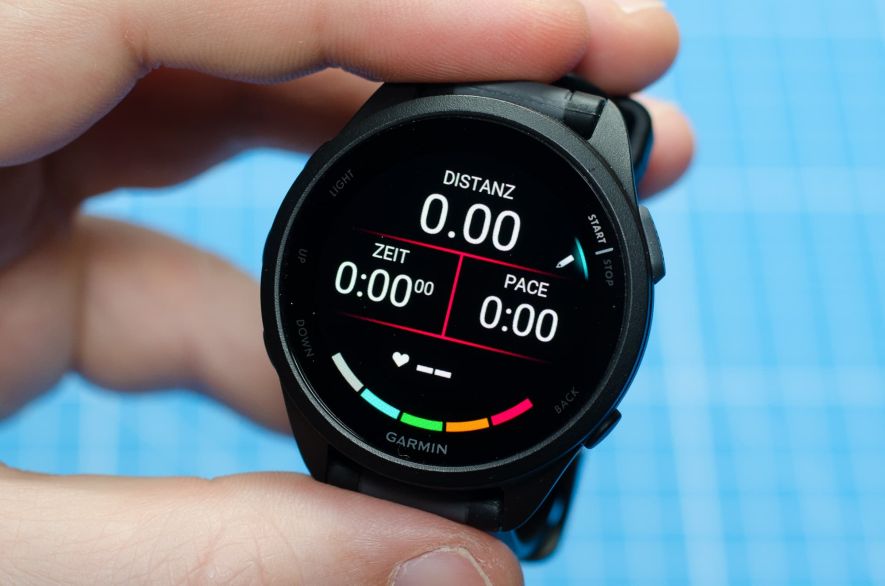
During an activity, you can scroll through data pages using the buttons. This also works with touch gestures, which I prefer to keep disabled.
After recording ends, Garmin automatically synchronizes the Forerunner 165 with the app or cloud, allowing you to review your workout (as well as daily metrics) on your wrist, smartphone, or tablet.

Most of the data is readily available on the watch. For additional information from paired sensors, it’s worthwhile to check the more comprehensive app. Garmin also offers the convenience of accessing this data through the Garmin Connect web portal.
In addition to the very text-heavy analysis on the first screens in the app, the data is also presented more attractively in charts:
To check if the data relates one way or the other, you can overlay various charts.
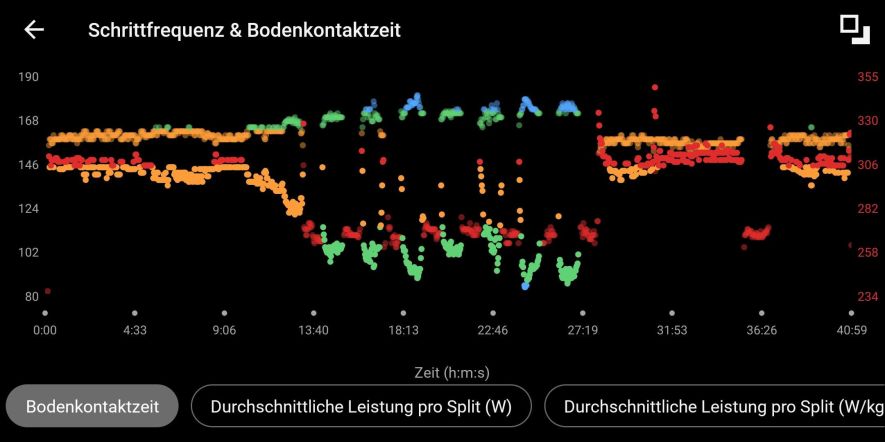
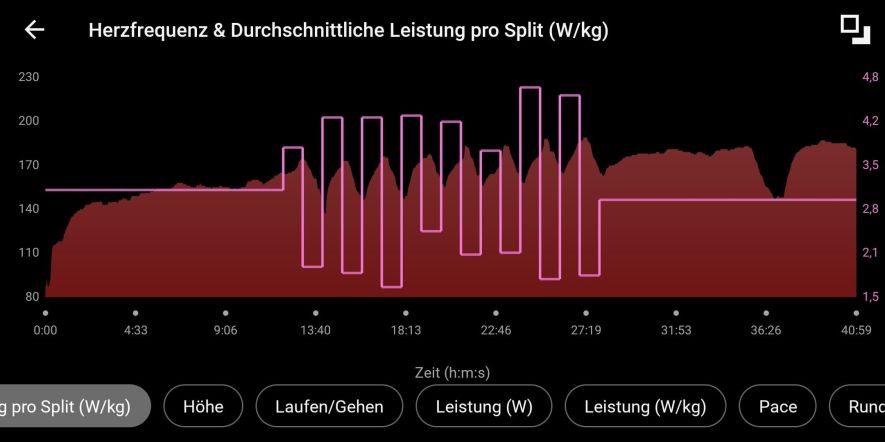
This allows for some nice composed charts, perfect for showing off to friends and family :)
A step back to sensors: The Forerunner 165 supports pairing with external sensors via Bluetooth and ANT+. Additionally, it can also act as an external sensor itself, transmitting heart rate data via BLE or ANT+ to other devices.
Accuracy in Location Data Determination
With GPS, GLONASS, and Galileo, the Forerunner 165 supports the main satellite systems used for positioning. However, compared to more expensive models, it lacks SatIQ and multiband capability, i.e., simultaneous use of the L1 and L5 frequency bands.

In challenging environments, such as mountains, areas with dense buildings, or densely wooded forests, some accuracy may be sacrificed because the secondary signal cannot be used to correct timing errors. For most casual runners, multiband GPS is generally not necessary.
Many questions I receive revolve around the fact that multiband GPS does not actually increase GPS accuracy but rather helps reduce errors primarily caused by signal reflection.
Of course, I also took the Forerunner 165 out and compared it with the following sports watches:
- Polar Ignite 3
- Amazfit Cheetah Pro
- Coros Pace 3
- Forerunner 245
Dense construction is hard to find here, and the Berlin outskirts also lack mountains, but it does offer sections through forests, residential areas, and open fields.
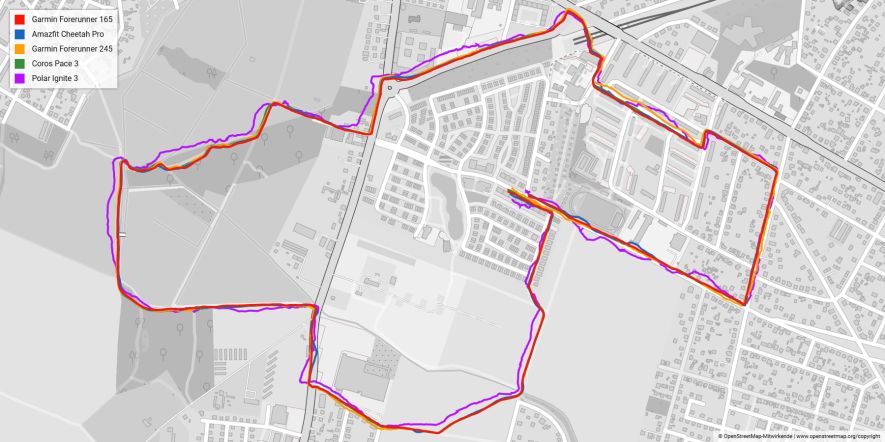
From a high-level perspective, all participants’ recordings are quite similar. However, the Polar Ignite 3 follows a noticeably different path, and at times, the Forerunner 245 appears to deviate in a similar manner.

And actually, it doesn’t matter where you run with the Forerunner 165; the results always make a good impression, even if you can’t shake the feeling that Garmin smooths the values more than the competition.
But let’s take a closer look at the following run.

On closer inspection, it becomes clear that even the Forerunner 165 has its quirks. This means that the watch sometimes positions itself a few meters off the road, not on the sidewalk but in front gardens. This is not a specific problem of sports watches but an issue with GPS accuracy in general.

Overall, the results are good to very good, as the new Garmin model shows few outliers and provides consistent performance.

Even the section through the now heavily wooded forest is completed without issues by the watch.
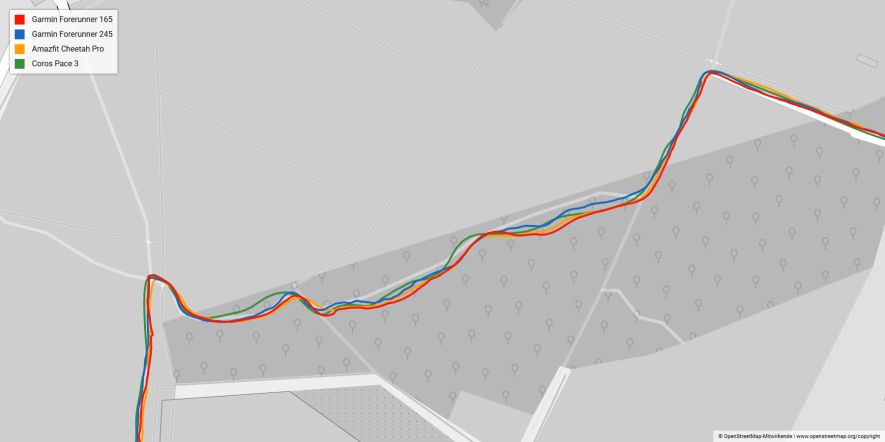
In my view, the Forerunner 165 performs strongly across all disciplines. There are no significant or consistent outliers in its recordings. When it does deviate, it’s only briefly and is generally on par with much more expensive models.
Accuracy in Heart Rate Recording
Besides route accuracy, no topic triggers people more than the accuracy of heart rate recordings. Here too, the Forerunner 165 had to measure up against models from Polar, Coros, and the Forerunner 245. The Amazfit Cheetah Pro, on the other hand, picked up data from the Polar H10 chest strap, which, despite its age, is one of the most accurate and reliable sensors available. For this reason, I like to use it as a reference for determining r².
Let’s look at a few runs with warm-up, intervals, and cool-down.

And as if the H10 chest strap wanted to disprove me, it has a dropout right at the beginning of the recording. Strap shifting or contacts not wet enough – it’s hard to say today. After a few minutes, the chest strap got back on track.
The sports watches, however, are all quite close to each other. When looking at the difference from the chest strap and ignoring the initial outlier, you see a typical shift along the time axis, i.e., the watch’s PPG sensor is a bit slower in detecting heart rate changes.


Interestingly, the Forerunner 245 with the older third-generation Elevate sensor provides nearly identical values compared to the fourth-generation Elevate sensor.

How close the values of the chest strap and the sports watches are is shown by the coefficient of determination r². The closer the value is to 1, the better the sports watches “follow” the chest strap.
Due to the slower response, the Forerunner 165 lags behind the other sports watches with a value of 0.905. The Coros Pace 3 matches the chest strap’s values best. But these are only gradual differences.

On the next run, the Forerunner 165’s slower response reappears during the intervals, showing the first signs of this issue once again.

Here too, it’s clear how similar the two generations of Elevate technology are. The Forerunner 165 takes longer to detect rapid heart rate changes during intervals.

The older technology of the Forerunner 245 is often closer to the values of the HR chest strap.

As with the previous run, the Forerunner 165 ranks last in the comparison of coefficients of determination with a value of 0.941. The Coros Pace 3 emerges as the performance leader once again with a coefficient of 0.984. However, these are minor differences, and all watches deliver solid results.
In scenarios with steady heart rates, such as during a regular run, all models perform similarly, with no significant outliers observed in the Forerunner 165 or any other models.
In summary, the performance of the Forerunner 165 is commendable, ranging from good to very good.
Comfort
After 60 days of testing, I can also comment on comfort. It’s quite good: The watch is light, compact, and unobtrusive in daily life.
The strap has caused me some issues, and I can’t pinpoint exactly why: The narrow 18-mm silicone strap has caused skin irritations much more often than, for example, the wide strap of a Polar Vantage V3 (Review | German).
My skin under the strap was much more frequently moist, and the strap rubbed despite a normal fit. After just three weeks, I had to keep switching the Forerunner 165 between my left and right wrist to give each wrist time to recover. In the end, both wrists were significantly marked.
Experiences from other users show, however, that this is not a general problem with the Forerunner watch or Garmin. It’s my personal issue with narrow silicone straps. If you find yourself in a similar situation, I strongly recommend nylon bands, which are also available in the right sizes for the Forerunner 165. This will eliminate the problems almost instantly.
Battery Life
I always hesitate to evaluate battery life in detail. It depends on so many factors (e.g., always-on use, number of display activations, display brightness, power-off time, GNSS systems, music playback, etc.) that it’s unlikely to find two identical scenarios.
When used as a smartwatch with gesture-based display activation, it easily lasts a full week. Garmin states the battery life as up to 11 days. Since a weekend is always a regular occasion to charge the watch, I usually do it every seven days.
A completely empty battery takes about 100 minutes to fully charge. After that, it provides enough power for many hours of recording, even when using multiple GNSS systems.
For those who want to know exactly, you can try to get an impression from Garmin’s breakdown.
Garmin Forerunner 165 - Verdict

- great display
- feature-packed
- no multisport / triathlon
- no training load / training readiness
- lots of plastic
After 60 days of testing, the Forerunner 165 proves to be an exceptionally well-equipped sports watch. Especially beginner runners and even ambitious runners will not miss any features if running is the focus. Even those who increase their expectations over time will find the Forerunner 165 to be a good training partner. However, the possibilities for structured training planning, taking into account training load and recovery, are reserved for the higher-end models.
Although Garmin focuses the watch on running sports, it is also a great companion for many other sports. It just offers a larger range of features specifically for running.
With the AMOLED display, touch control, and also button control, Garmin combines what I believe to be the best approaches for using the watch. The two buttons on the otherwise quite similar vivoactive 5 almost feel a bit limiting in comparison.
The biggest challenge for the watch will likely come from the competition. For its price and the functions it offers for everyday use, there are few alternatives. However, those who don’t need the ultimate all-rounder will find numerous and sometimes more affordable options. Models such as the Coros Pace 3, Polar Ignite 3 or Pacer Pro, and the Amazfit Cheetah Pro are also highly recommended and can be significantly cheaper.
Disclosure: The Forerunner 165 to me by Garmin, free of charge, at my request for testing. No conditions were attached to this review, and the opinions and experiences shared here reflect my entirely unbiased assessment of the product.

